reactjs源码分析
reactjs virtual dom 源码分析
reactjs的核心内容并不多,主要是下面这些:
- 虚拟dom对象(Virtual DOM)
- 虚拟dom差异化算法(diff algorithm)
- 单向数据流渲染(Data Flow)
- 组件生命周期
- 事件处理
下面我们将一点点的来实现一个简易版的reactjs,实现上面的那些功能,最后用这个reactjs做一个todolist的小应用,看完这个,或者跟着敲一遍代码。希望让大家能够更好的理解reactjs的运行原理。实例源码都托管在github。点这里里面有分步骤的例子,可以一边看一边运行例子。
首次渲染
基本骨架
下面我们将一点点的来实现一个简易版的reactjs(仅仅使用jquery),实现上面的那些功能,先从渲染hello world开始看下面的代码:
<script type="text/javascript">
React.render('hello world',document.getElementById("container"))
</script>
/**
对应的html为
<div id="container"></div>
生成后的html为:
<div id="container">
<span data-reactid="0">hello world</span>
</div>
*/
假定这一行代码,就可以把hello world渲染到对应的div里面。我们来看看我们需要为此做些什么:
//component类,用来表示文本在渲染,更新,删除时应该做些什么事情
function ReactDOMTextComponent(text) {
//存下当前的字符串
this._currentElement = '' + text;
//用来标识当前component
this._rootNodeID = null;
}
//component渲染时生成的dom结构
ReactDOMTextComponent.prototype.mountComponent = function(rootID) {
this._rootNodeID = rootID;
return '<span data-reactid="' + rootID + '">' + this._currentElement + '</span>';
}
//component工厂 用来返回一个component实例
function instantiateReactComponent(node){
if(typeof node === 'string' || typeof node === 'number'){ //暂时只支持文本
return new ReactDOMTextComponent(node)
}
}
React = {
nextReactRootIndex:0,
render:function(element,container){
var componentInstance = instantiateReactComponent(element);
var markup = componentInstance.mountComponent(React.nextReactRootIndex++);
$(container).html(markup);
//触发完成mount的事件
$(document).trigger('mountReady'); }
}
代码分为三个部分:
- React.render 作为入口负责调用渲染
- 引入了component类的概念,ReactDOMTextComponent是一个component类定义,定义对于这种文本类型的节点,在渲染,更新,删除时应该做什么操作,这边暂时只用到渲染,另外两个可以先忽略
- instantiateReactComponent用来根据element的类型(现在只有一种string类型),返回一个component的实例。其实就是个类工厂。
nextReactRootIndex作为每个component的标识id,不断加1,确保唯一性。这样我们以后可以通过这个标识找到这个元素。可以看到我们把逻辑分为几个部分,主要的渲染逻辑放在了具体的componet类去定义。React.render负责调度整个流程,这里是调用instantiateReactComponent生成一个对应component类型的实例对象,然后调用此对象的mountComponent获取生成的内容。最后写到对应的container节点中。
HTML元素
我们希望Component(虚拟dom)类型除了文本之外支持浏览器自带的基本元素比如div p input form这种,比如在hello world外面包一层div,并且带上一些属性,甚至事件时我们可以这么写:
//演示事件监听怎么用
function hello(){
alert('hello')
}
//假设我们把虚拟dom模型定义成类似{ type: '…', props: { … }, children: [ … ] }这样的数据结构
var element = React.createElement('div',{id:'test',onclick:hello},'click me')
React.render(element,document.getElementById("container"))
/**
//生成的html为:
<div data-reactid="0" id="test">
<span data-reactid="0.0">click me</span>
</div>
//点击文字,会弹出hello的对话框
*/
我们来看看简易版本React.createElement的实现:
//ReactElement就是虚拟dom的概念,具有一个type属性代表当前的节点类型,还有节点的属性props
//比如对于div这样的节点type就是div,props就是那些attributes
//另外这里的key,可以用来标识这个element,用于优化以后的更新,这里可以先不管,知道有这么个东西就好了
function ReactElement(type,key,props){
this.type = type;
this.key = key;
this.props = props;
}
React = {
nextReactRootIndex:0,
createElement:function(type,config,children){
var props = {},propName;
config = config || {}
//看有没有key,用来标识element的类型,方便以后高效的更新,这里可以先不管
var key = config.key || null;
//复制config里的内容到props
for (propName in config) {
if (config.hasOwnProperty(propName) && propName !== 'key') {
props[propName] = config[propName];
}
}
//处理children,全部挂载到props的children属性上
//支持两种写法,如果只有一个参数,直接赋值给children,否则做合并处理
var childrenLength = arguments.length - 2;
if (childrenLength === 1) {
props.children = $.isArray(children) ? children : [children] ;
} else if (childrenLength > 1) {
var childArray = Array(childrenLength);
for (var i = 0; i < childrenLength; i++) {
childArray[i] = arguments[i + 2];
}
props.children = childArray;
}
return new ReactElement(type, key,props);
},
render:function(element,container){
var componentInstance = instantiateReactComponent(element);
var markup = componentInstance.mountComponent(React.nextReactRootIndex++);
$(container).html(markup);
//触发完成mount的事件
$(document).trigger('mountReady');
}
}
增加了createElement函数返回一个ReactElement实例对象也就是我们说的虚拟元素的实例。有了元素实例,我们得把他渲染出来,此时render接受的是一个ReactElement而不是文本,我们先改造下instantiateReactComponent:
function instantiateReactComponent(node){
//文本节点的情况
if(typeof node === 'string' || typeof node === 'number'){
return new ReactDOMTextComponent(node);
}
//浏览器默认节点的情况
if(typeof node === 'object' && typeof node.type === 'string'){
//注意这里,使用了一种新的component
return new ReactDOMComponent(node);
}
}
增加了一个判断,这样当render的不是文本而是浏览器的基本元素时。我们使用另外一种component来处理它渲染时应该返回的内容。这里就体现了工厂方法instantiateReactComponent的好处了,不管来了什么类型的node,都可以负责生产出一个负责渲染的component实例。这样render完全不需要做任何修改,只需要再做一种对应的component类型(这里是ReactDOMComponent)就行了。所以重点我们来看看ReactDOMComponent的具体实现:
//component类,用来表示文本在渲染,更新,删除时应该做些什么事情
function ReactDOMComponent(element){
//存下当前的element对象引用
this._currentElement = element;
this._rootNodeID = null;
}
//component渲染时生成的dom结构
ReactDOMComponent.prototype.mountComponent = function(rootID){
//赋值标识
this._rootNodeID = rootID;
var props = this._currentElement.props;
var tagOpen = '<' + this._currentElement.type;
var tagClose = '</' + this._currentElement.type + '>';
//加上reactid标识
tagOpen += ' data-reactid=' + this._rootNodeID;
//拼凑出属性
for (var propKey in props) {
//这里要做一下事件的监听,就是从属性props里面解析拿出on开头的事件属性的对应事件监听
if (/^on[A-Za-z]/.test(propKey)) {
var eventType = propKey.replace('on', '');
//针对当前的节点添加事件代理,以_rootNodeID为命名空间
$(document).delegate('[data-reactid="' + this._rootNodeID + '"]', eventType + '.' + this._rootNodeID, props[propKey]);
}
//对于children属性以及事件监听的属性不需要进行字符串拼接
//事件会代理到全局。这边不能拼到dom上不然会产生原生的事件监听
if (props[propKey] && propKey != 'children' && !/^on[A-Za-z]/.test(propKey)) {
tagOpen += ' ' + propKey + '=' + props[propKey];
}
}
//获取子节点渲染出的内容
var content = '';
var children = props.children || [];
var childrenInstances = []; //用于保存所有的子节点的componet实例,以后会用到
var that = this;
$.each(children, function(key, child) {
//这里再次调用了instantiateReactComponent实例化子节点component类,拼接好返回
var childComponentInstance = instantiateReactComponent(child);
childComponentInstance._mountIndex = key;
childrenInstances.push(childComponentInstance);
//子节点的rootId是父节点的rootId加上新的key也就是顺序的值拼成的新值
var curRootId = that._rootNodeID + '.' + key;
//得到子节点的渲染内容
var childMarkup = childComponentInstance.mountComponent(curRootId);
//拼接在一起
content += ' ' + childMarkup;
})
//留给以后更新时用的这边先不用管
this._renderedChildren = childrenInstances;
//拼出整个html内容
return tagOpen + '>' + content + tagClose;
}
我们增加了虚拟dom reactElement的定义,增加了一个新的componet类ReactDOMComponent。这样我们就实现了渲染浏览器基本元素的功能了。对于虚拟dom的渲染逻辑,本质上还是个递归渲染的东西,reactElement会递归渲染自己的子节点。可以看到我们通过instantiateReactComponent屏蔽了子节点的差异,只需要使用不同的componet类,这样都能保证通过mountComponent最终拿到渲染后的内容。另外这边的事件也要说下,可以在传递props的时候传入{onClick:function(){}}这样的参数,这样就会在当前元素上添加事件,代理到document $(document).delegate('[data-reactid="' + this._rootNodeID + '"]', eventType + '.' + this._rootNodeID, props[propKey]); 由于reactjs本身全是在写js,所以监听的函数的传递变得特别简单。
这里很多东西没有考虑,比如一些特殊的类型input select等等,再比如img不需要有对应的tagClose等。这里为了保持简单就不再扩展了。另外reactjs的事件处理其实很复杂,实现了一套标准的w3c事件。这里偷懒直接使用jQuery的事件代理到document上了。
自定义组合元素
下面实现自定义元素的功能。我们上面element.type只是个简单的字符串,如果是个类呢?如果这个类恰好还有自己的生命周期管理,那扩展性就很高了。还是先看看reactjs怎么使用自定义元素,从使用反推实现:
var HelloMessage = React.createClass({
getInitialState: function() {
return {type: 'say:'};
},
componentWillMount: function() {
console.log('我就要开始渲染了。。。')
},
componentDidMount: function() {
console.log('我已经渲染好了。。。')
},
render: function() {
return React.createElement("div", null,this.state.type, "Hello ", this.props.name);
}
});
React.render(React.createElement(HelloMessage, {name: "John"}), document.getElementById("container"));
/**
结果为:
html:
<div data-reactid="0">
<span data-reactid="0.0">say:</span>
<span data-reactid="0.1">Hello </span>
<span data-reactid="0.2">John</span>
</div>
console:
我就要开始渲染了。。。
我已经渲染好了。。。
*/
React.createElement接受的不再是字符串,而是一个class。React.createClass生成一个自定义标记类,带有基本的生命周期:
- getInitialState 获取最初的属性值this.state
- componentWillmount 在组件准备渲染时调用
- componentDidMount 在组件渲染完成后调用
对reactjs稍微有点了解的应该都可以明白上面的用法,先来看看React.createClass的实现:
//定义ReactClass类,所有自定义的超级父类
var ReactClass = function(){
}
//留给子类去继承覆盖
ReactClass.prototype.render = function(){}
React = {
nextReactRootIndex:0,
createClass:function(spec){
//生成一个子类
var Constructor = function (props) {
this.props = props;
this.state = this.getInitialState ? this.getInitialState() : null;
}
//原型继承,继承超级父类
Constructor.prototype = new ReactClass();
Constructor.prototype.constructor = Constructor;
//混入spec到原型
$.extend(Constructor.prototype,spec);
return Constructor;
},
createElement:function(type,config,children){
...
},
render:function(element,container){
...
}
}
可以看到createClass生成了一个继承ReactClass的子类,在构造函数里调用this.getInitialState获得最初的state。
为了演示方便,我们这边的ReactClass相当简单,实际上原始的代码处理了很多东西,比如类的mixin的组合继承支持,比如componentDidMount等可以定义多次,需要合并调用等等,有兴趣的去翻源码吧,不是本文的主要目的,这里就不详细展开了。
我们这里只是返回了一个继承类的定义,那么具体的componentWillmount,这些生命周期函数在哪里调用呢。看看我们上面的两种类型就知道,我们是时候为自定义元素也提供一个componet类了,在那个类里我们会实例化ReactClass,并且管理生命周期,还有父子组件依赖。老规矩先改造instantiateReactComponent:
function instantiateReactComponent(node){
//文本节点的情况
if(typeof node === 'string' || typeof node === 'number'){
return new ReactDOMTextComponent(node);
}
//浏览器默认节点的情况
if(typeof node === 'object' && typeof node.type === 'string'){
//注意这里,使用了一种新的component
return new ReactDOMComponent(node);
}
//自定义的元素节点
if(typeof node === 'object' && typeof node.type === 'function'){
//注意这里,使用新的component,专门针对自定义元素
return new ReactCompositeComponent(node);
}
}
很简单我们增加了一个判断,使用新的component类形来处理自定义的节点。我们看下ReactCompositeComponent的具体实现:
function ReactCompositeComponent(element){
//存放元素element对象
this._currentElement = element;
//存放唯一标识
this._rootNodeID = null;
//存放对应的ReactClass的实例
this._instance = null;
}
//用于返回当前自定义元素渲染时应该返回的内容
ReactCompositeComponent.prototype.mountComponent = function(rootID){
this._rootNodeID = rootID;
//拿到当前元素对应的属性值
var publicProps = this._currentElement.props;
//拿到对应的ReactClass
var ReactClass = this._currentElement.type;
// Initialize the public class
var inst = new ReactClass(publicProps);
this._instance = inst;
//保留对当前comonent的引用,下面更新会用到
inst._reactInternalInstance = this;
if (inst.componentWillMount) {
inst.componentWillMount();
//这里在原始的reactjs其实还有一层处理,就是 componentWillMount调用setstate,不会触发rerender而是自动提前合并,这里为了保持简单,就略去了
}
//调用ReactClass的实例的render方法,返回一个element或者一个文本节点
var renderedElement = this._instance.render();
//得到renderedElement对应的component类实例
var renderedComponentInstance = instantiateReactComponent(renderedElement);
this._renderedComponent = renderedComponentInstance; //存起来留作后用
//拿到渲染之后的字符串内容,将当前的_rootNodeID传给render出的节点
var renderedMarkup = renderedComponentInstance.mountComponent(this._rootNodeID);
//之前我们在React.render方法最后触发了mountReady事件,所以这里可以监听,在渲染完成后会触发。
$(document).on('mountReady', function() {
//调用inst.componentDidMount
inst.componentDidMount && inst.componentDidMount();
});
return renderedMarkup;
}
实现并不难,ReactClass的render一定是返回一个虚拟节点(包括element和text),这个时候我们使用instantiateReactComponent去得到实例,再使用mountComponent拿到结果作为当前自定义元素的结果。应该说本身自定义元素不负责具体的内容,他更多的是负责生命周期。具体的内容是由它的render方法返回的虚拟节点来负责渲染的。本质上也是递归的去渲染内容的过程。同时因为这种递归的特性,父组件的componentWillMount一定在某个子组件的componentWillMount之前调用,而父组件的componentDidMount肯定在子组件之后.上面实现了三种类型的元素,其实我们发现本质上没有太大的区别,都是有自己对应component类来处理自己的渲染过程。大概的关系是下面这样。
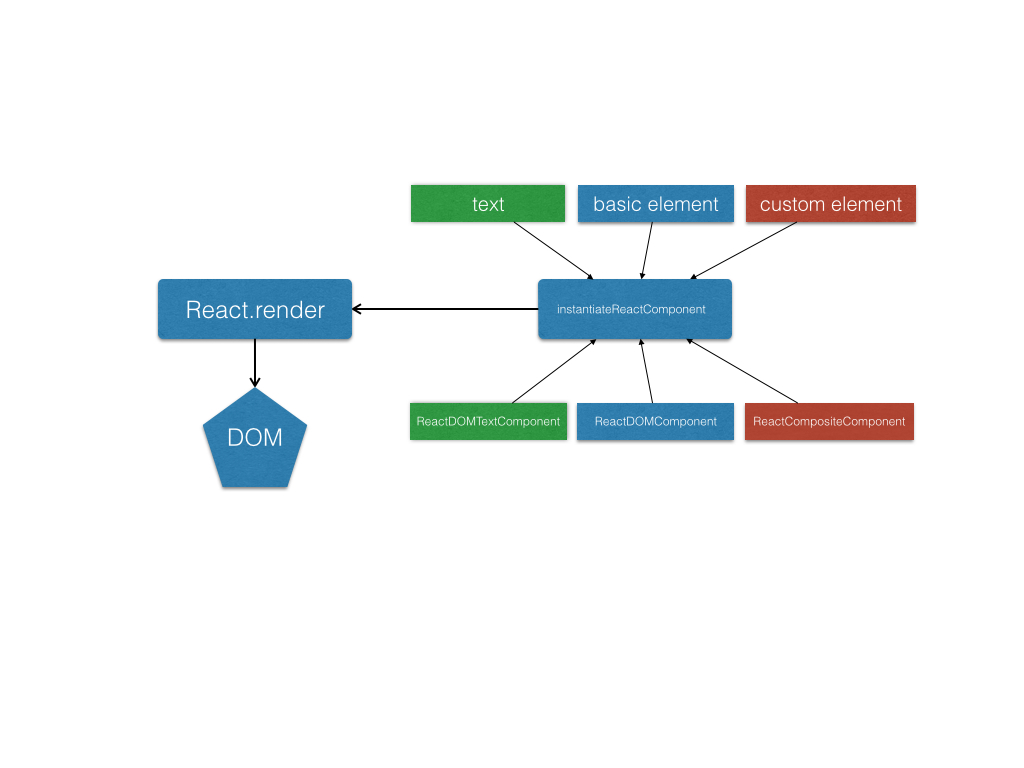
更新机制
节点比较算法原理
在React中,树的算法其实非常简单,那就是两棵树只会对同一层次的节点进行比较。如下图所示:
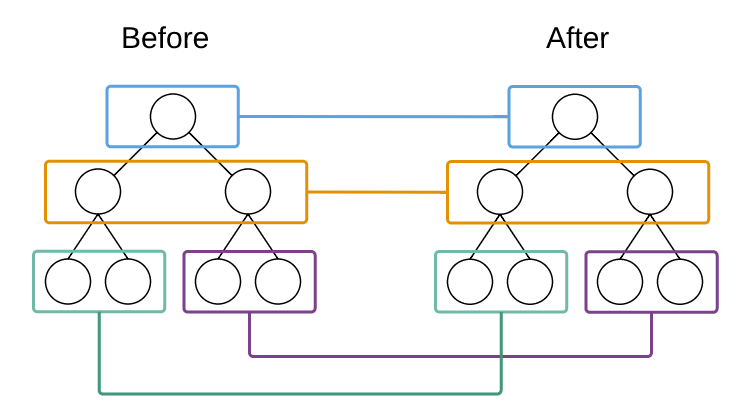
React只会对相同颜色方框内的DOM节点进行比较,即同一个父节点下的所有子节点。当发现节点已经不存在,则该节点及其子节点会被完全删除掉,不会用于进一步的比较。这样只需要对树进行一次遍历,便能完成整个DOM树的比较。
相同类型节点的比较
第二种节点的比较是相同类型的节点,算法就相对简单而容易理解。React会对属性进行重设从而实现节点的转换。例如:
renderA: <div id="before" />
renderB: <div id="after" />
=> [replaceAttribute id "after"]
虚拟DOM的style属性稍有不同,其值并不是一个简单字符串而必须为一个对象,因此转换过程如下:
renderA: <div style={{color: 'red'}} />
renderB: <div style={{fontWeight: 'bold'}} />
=> [removeStyle color], [addStyle font-weight 'bold']
不同节点类型的比较
当一个节点从div变成span时,简单的直接删除div节点,并插入一个新的span节点。
renderA: <div />
renderB: <span />
=> [removeNode <div />], [insertNode <span />]
例如,考虑有下面的DOM结构转换:
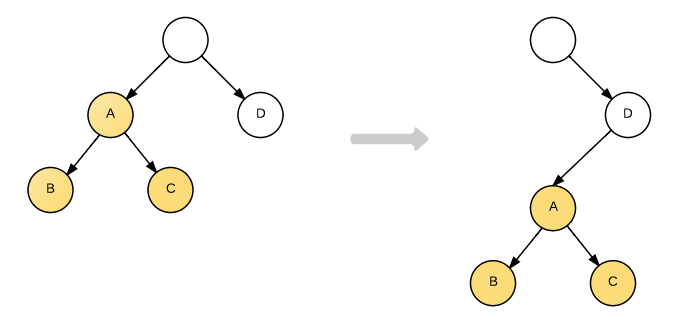
A节点被整个移动到D节点下,直观的考虑DOM Diff操作应该是
A.parent.remove(A);
D.append(A);
但因为React只会简单的考虑同层节点的位置变换,对于不同层的节点,只有简单的创建和删除。当根节点发现子节点中A不见了,就会直接销毁A;而当D发现自己多了一个子节点A,则会创建一个新的A作为子节点。因此对于这种结构的转变的实际操作是:
A.destroy();
A = new A();
A.append(new B());
A.append(new C());
D.append(A);
可以看到,以A为根节点的树被整个重新创建。
算法实现
虚拟dom差异化算法(diff algorithm)是reactjs最核心的东西,按照官方的说法。他非常快,非常高效。目前已经有一些分析此算法的文章,但是仅仅停留在表面。所以我们下面自己动手实现一遍,等你完全实现了,再去看那些文字图片流的介绍文章,就会发现容易理解多了。一般在reactjs中我们需要更新时都是调用的setState。看下面的例子:
var HelloMessage = React.createClass({
getInitialState: function() {
return {type: 'say:'};
},
changeType:function(){
this.setState({type:'shout:'})
},
render: function() {
return React.createElement("div", {onclick:this.changeType},this.state.type, "Hello ", this.props.name);
}
});
React.render(React.createElement(HelloMessage, {name: "John"}), document.getElementById("container"));
/**
//生成的html为:
<div data-reactid="0" id="test">
<span data-reactid="0.0">say hello world</span>
</div>
点击文字,say会变成shout
*/
点击文字,调用setState就会更新,所以我们扩展下ReactClass,看下setState的实现:
//定义ReactClass类
var ReactClass = function(){
}
ReactClass.prototype.render = function(){}
//setState
ReactClass.prototype.setState = function(newState) {
//还记得我们在ReactCompositeComponent里面mount的时候 做了赋值
//所以这里可以拿到 对应的ReactCompositeComponent的实例_reactInternalInstance
this._reactInternalInstance.receiveComponent(null, newState);
}
可以看到setState主要调用了对应的component的receiveComponent来实现更新。所有的挂载,更新都应该交给对应的component来管理。就像所有的component都实现了mountComponent来处理第一次渲染,所有的componet类都应该实现receiveComponent用来处理自己的更新。
自定义元素的receiveComponent
所以我们照葫芦画瓢来给自定义元素的对应component类(ReactCompositeComponent)实现一个receiveComponent方法:
//更新
ReactCompositeComponent.prototype.receiveComponent = function(nextElement, newState) {
//如果接受了新的,就使用最新的element
this._currentElement = nextElement || this._currentElement
var inst = this._instance;
//合并state
var nextState = $.extend(inst.state, newState);
var nextProps = this._currentElement.props;
//改写state
inst.state = nextState;
//如果inst有shouldComponentUpdate并且返回false。说明组件本身判断不要更新,就直接返回。
if (inst.shouldComponentUpdate && (inst.shouldComponentUpdate(nextProps, nextState) === false)) return;
//生命周期管理,如果有componentWillUpdate,就调用,表示开始要更新了。
if (inst.componentWillUpdate) inst.componentWillUpdate(nextProps, nextState);
var prevComponentInstance = this._renderedComponent;
var prevRenderedElement = prevComponentInstance._currentElement;
//重新执行render拿到对应的新element;
var nextRenderedElement = this._instance.render();
//判断是需要更新还是直接就重新渲染
//注意这里的_shouldUpdateReactComponent跟上面的不同哦 这个是全局的方法
if (_shouldUpdateReactComponent(prevRenderedElement, nextRenderedElement)) {
//如果需要更新,就继续调用子节点的receiveComponent的方法,传入新的element更新子节点。
prevComponentInstance.receiveComponent(nextRenderedElement);
//调用componentDidUpdate表示更新完成了
inst.componentDidUpdate && inst.componentDidUpdate();
} else {
//如果发现完全是不同的两种element,那就干脆重新渲染了
var thisID = this._rootNodeID;
//重新new一个对应的component,
this._renderedComponent = this._instantiateReactComponent(nextRenderedElement);
//重新生成对应的元素内容
var nextMarkup = _renderedComponent.mountComponent(thisID);
//替换整个节点
$('[data-reactid="' + this._rootNodeID + '"]').replaceWith(nextMarkup);
}
}
//用来判定两个element需不需要更新
//这里的key是我们createElement的时候可以选择性的传入的。用来标识这个element,当发现key不同时,我们就可以直接重新渲染,不需要去更新了。
var _shouldUpdateReactComponent = function(prevElement, nextElement){
if (prevElement != null && nextElement != null) {
var prevType = typeof prevElement;
var nextType = typeof nextElement;
if (prevType === 'string' || prevType === 'number') {
return nextType === 'string' || nextType === 'number';
} else {
return nextType === 'object' && prevElement.type === nextElement.type && prevElement.key === nextElement.key;
}
}
return false;
}
不要被这么多代码吓到,其实流程很简单。它主要做了什么事呢?首先会合并改动,生成最新的state,props然后拿以前的render返回的element跟现在最新调用render生成的element进行对比(_shouldUpdateReactComponent),看看需不需要更新,如果要更新就继续调用对应的component类对应的receiveComponent就好啦,其实就是直接当甩手掌柜,事情直接丢给手下去办了。当然还有种情况是,两次生成的element差别太大,就不是一个类型的,那好办直接重新生成一份新的代码重新渲染一次就o了。本质上还是递归调用receiveComponent的过程。这里注意两个函数:
- inst.shouldComponentUpdate是实例方法,当我们不希望某次setState后更新,我们就可以重写这个方法,返回false就好了。
- _shouldUpdateReactComponent是一个全局方法,这个是一种reactjs的优化机制。用来决定是直接全部替换,还是使用很细微的改动。当两次render出来的子节点key不同,直接全部重新渲染一遍,替换就好了。否则,我们就得来个递归的更新,保证最小化的更新机制,这样可以不会有太大的闪烁。另外可以看到这里还处理了一套更新的生命周期调用机制。
文本节点的receiveComponent
我们再看看文本节点的,比较简单:
ReactDOMTextComponent.prototype.receiveComponent = function(nextText) {
var nextStringText = '' + nextText;
//跟以前保存的字符串比较
if (nextStringText !== this._currentElement) {
this._currentElement = nextStringText;
//替换整个节点
$('[data-reactid="' + this._rootNodeID + '"]').html(this._currentElement);
}
}
没什么好说的,如果不同的话,直接找到对应的节点,更新就好了。
基本元素element的receiveComponent
最后我们开始看比较复杂的浏览器基本元素的更新机制。比如我们看看下面的html:
<div id="test" name="hello">
<span></span>
<span></span>
</div>
想一下我们怎么以最小代价去更新这段html呢。不难发现其实主要包括两个部分:
- 属性的更新,包括对特殊属性比如事件的处理
- 子节点的更新,这个比较复杂,为了得到最好的效率,我们需要处理下面这些问题: 拿新的子节点树跟以前老的子节点树对比,找出他们之间的差别。我们称之为diff 所有差别找出后,再一次性的去更新。我们称之为patch
所以更新代码结构如下:
ReactDOMComponent.prototype.receiveComponent = function(nextElement) {
var lastProps = this._currentElement.props;
var nextProps = nextElement.props;
this._currentElement = nextElement;
//需要单独的更新属性
this._updateDOMProperties(lastProps, nextProps);
//再更新子节点
this._updateDOMChildren(nextElement.props.children);
}
整体上也不复杂,先是处理当前节点属性的变动,后面再去处理子节点的变动.我们一步步来,先看看,更新属性怎么变更:
ReactDOMComponent.prototype._updateDOMProperties = function(lastProps, nextProps) {
var propKey;
//遍历,当一个老的属性不在新的属性集合里时,需要删除掉。
for (propKey in lastProps) {
//新的属性里有,或者propKey是在原型上的直接跳过。这样剩下的都是不在新属性集合里的。需要删除
if (nextProps.hasOwnProperty(propKey) || !lastProps.hasOwnProperty(propKey)) {
continue;
}
//对于那种特殊的,比如这里的事件监听的属性我们需要去掉监听
if (/^on[A-Za-z]/.test(propKey)) {
var eventType = propKey.replace('on', '');
//针对当前的节点取消事件代理
$(document).undelegate('[data-reactid="' + this._rootNodeID + '"]', eventType, lastProps[propKey]);
continue;
}
//从dom上删除不需要的属性
$('[data-reactid="' + this._rootNodeID + '"]').removeAttr(propKey)
}
//对于新的属性,需要写到dom节点上
for (propKey in nextProps) {
//对于事件监听的属性我们需要特殊处理
if (/^on[A-Za-z]/.test(propKey)) {
var eventType = propKey.replace('on', '');
//以前如果已经有,说明有了监听,需要先去掉
lastProps[propKey] && $(document).undelegate('[data-reactid="' + this._rootNodeID + '"]', eventType, lastProps[propKey]);
//针对当前的节点添加事件代理,以_rootNodeID为命名空间
$(document).delegate('[data-reactid="' + this._rootNodeID + '"]', eventType + '.' + this._rootNodeID, nextProps[propKey]);
continue;
}
if (propKey == 'children') continue;
//添加新的属性,或者是更新老的同名属性
$('[data-reactid="' + this._rootNodeID + '"]').prop(propKey, nextProps[propKey])
}
}
属性的变更并不是特别复杂,主要就是找到以前老的不用的属性直接去掉,新的属性赋值,并且注意其中特殊的事件属性做出特殊处理就行了。下面我们看子节点的更新,也是最复杂的部分。
ReactDOMComponent.prototype.receiveComponent = function(nextElement){
var lastProps = this._currentElement.props;
var nextProps = nextElement.props;
this._currentElement = nextElement;
//需要单独的更新属性
this._updateDOMProperties(lastProps,nextProps);
//再更新子节点
this._updateDOMChildren(nextProps.children);
}
//全局的更新深度标识
var updateDepth = 0;
//全局的更新队列,所有的差异都存在这里
var diffQueue = [];
ReactDOMComponent.prototype._updateDOMChildren = function(nextChildrenElements){
updateDepth++
//_diff用来递归找出差别,组装差异对象,添加到更新队列diffQueue。
this._diff(diffQueue,nextChildrenElements);
updateDepth--
if(updateDepth == 0){
//在需要的时候调用patch,执行具体的dom操作
this._patch(diffQueue);
diffQueue = [];
}
}
就像我们之前说的一样,更新子节点包含两个部分,一个是递归的分析差异,把差异添加到队列中。然后在合适的时机调用_patch把差异应用到dom上。那么什么是合适的时机,updateDepth又是干嘛的?这里需要注意的是,_diff内部也会递归调用子节点的receiveComponent于是当某个子节点也是浏览器普通节点,就也会走_updateDOMChildren这一步。所以这里使用了updateDepth来记录递归的过程,只有等递归回来updateDepth为0时,代表整个差异已经分析完毕,可以开始使用patch来处理差异队列了。所以我们关键是实现_diff与_patch两个方法。我们先看_diff的实现:
//差异更新的几种类型
var UPATE_TYPES = {
MOVE_EXISTING: 1,
REMOVE_NODE: 2,
INSERT_MARKUP: 3
}
//普通的children是一个数组,此方法把它转换成一个map,key就是element的key,如果是text节点或者element创建时并没有传入key,就直接用在数组里的index标识
function flattenChildren(componentChildren) {
var child;
var name;
var childrenMap = {};
for (var i = 0; i < componentChildren.length; i++) {
child = componentChildren[i];
name = child && child._currentelement && child._currentelement.key ? child._currentelement.key : i.toString(36);
childrenMap[name] = child;
}
return childrenMap;
}
//主要用来生成子节点elements的component集合
//这边注意,有个判断逻辑,如果发现是更新,就会继续使用以前的componentInstance,调用对应的receiveComponent。
//如果是新的节点,就会重新生成一个新的componentInstance,
function generateComponentChildren(prevChildren, nextChildrenElements) {
var nextChildren = {};
nextChildrenElements = nextChildrenElements || [];
$.each(nextChildrenElements, function(index, element) {
var name = element.key ? element.key : index;
var prevChild = prevChildren && prevChildren[name];
var prevElement = prevChild && prevChild._currentElement;
var nextElement = element;
//调用_shouldUpdateReactComponent判断是否是更新
if (_shouldUpdateReactComponent(prevElement, nextElement)) {
//更新的话直接递归调用子节点的receiveComponent就好了
prevChild.receiveComponent(nextElement);
//然后继续使用老的component
nextChildren[name] = prevChild;
} else {
//对于没有老的,那就重新新增一个,重新生成一个component
var nextChildInstance = instantiateReactComponent(nextElement, null);
//使用新的component
nextChildren[name] = nextChildInstance;
}
})
return nextChildren;
}
//_diff用来递归找出差别,组装差异对象,添加到更新队列diffQueue。
ReactDOMComponent.prototype._diff = function(diffQueue, nextChildrenElements) {
var self = this;
//拿到之前的子节点的 component类型对象的集合,这个是在刚开始渲染时赋值的,记不得的可以翻上面
//_renderedChildren 本来是数组,我们搞成map
var prevChildren = flattenChildren(self._renderedChildren);
//生成新的子节点的component对象集合,这里注意,会复用老的component对象
var nextChildren = generateComponentChildren(prevChildren, nextChildrenElements);
//重新赋值_renderedChildren,使用最新的。
self._renderedChildren = []
$.each(nextChildren, function(key, instance) {
self._renderedChildren.push(instance);
})
var nextIndex = 0; //代表到达的新的节点的index
//通过对比两个集合的差异,组装差异节点添加到队列中
for (name in nextChildren) {
if (!nextChildren.hasOwnProperty(name)) {
continue;
}
var prevChild = prevChildren && prevChildren[name];
var nextChild = nextChildren[name];
//相同的话,说明是使用的同一个component,所以我们需要做移动的操作
if (prevChild === nextChild) {
//添加差异对象,类型:MOVE_EXISTING
diffQueue.push({
parentId: self._rootNodeID,
parentNode: $('[data-reactid=' + self._rootNodeID + ']'),
type: UPATE_TYPES.MOVE_EXISTING,
fromIndex: prevChild._mountIndex,
toIndex: nextIndex
})
} else { //如果不相同,说明是新增加的节点
//但是如果老的还存在,就是element不同,但是component一样。我们需要把它对应的老的element删除。
if (prevChild) {
//添加差异对象,类型:REMOVE_NODE
diffQueue.push({
parentId: self._rootNodeID,
parentNode: $('[data-reactid=' + self._rootNodeID + ']'),
type: UPATE_TYPES.REMOVE_NODE,
fromIndex: prevChild._mountIndex,
toIndex: null
})
//如果以前已经渲染过了,记得先去掉以前所有的事件监听,通过命名空间全部清空
if (prevChild._rootNodeID) {
$(document).undelegate('.' + prevChild._rootNodeID);
}
}
//新增加的节点,也组装差异对象放到队列里
//添加差异对象,类型:INSERT_MARKUP
diffQueue.push({
parentId: self._rootNodeID,
parentNode: $('[data-reactid=' + self._rootNodeID + ']'),
type: UPATE_TYPES.INSERT_MARKUP,
fromIndex: null,
toIndex: nextIndex,
markup: nextChild.mountComponent() //新增的节点,多一个此属性,表示新节点的dom内容
})
}
//更新mount的index
nextChild._mountIndex = nextIndex;
nextIndex++;
}
//对于老的节点里有,新的节点里没有的那些,也全都删除掉
for (name in prevChildren) {
if (prevChildren.hasOwnProperty(name) && !(nextChildren && nextChildren.hasOwnProperty(name))) {
//添加差异对象,类型:REMOVE_NODE
diffQueue.push({
parentId: self._rootNodeID,
parentNode: $('[data-reactid=' + self._rootNodeID + ']'),
type: UPATE_TYPES.REMOVE_NODE,
fromIndex: prevChild._mountIndex,
toIndex: null
})
//如果以前已经渲染过了,记得先去掉以前所有的事件监听
if (prevChildren[name]._rootNodeID) {
$(document).undelegate('.' + prevChildren[name]._rootNodeID);
}
}
}
}
我们分析下上面的代码,咋一看好多,好复杂,不急我们从入口开始看。首先我们拿到之前的component的集合,如果是第一次更新的话,这个值是我们在渲染时赋值的。然后我们调用generateComponentChildren生成最新的component集合。我们知道component是用来放element的,一个萝卜一个坑。注意flattenChildren我们这里把数组集合转成了对象map,以element的key作为标识,当然对于text文本或者没有传入key的element,直接用index作为标识。通过这些标识,我们可以从类型的角度来判断两个component是否是一样的。generateComponentChildren会尽量的复用以前的component,也就是那些坑,当发现可以复用component(也就是key一致)时,就还用以前的,只需要调用他对应的更新方法receiveComponent就行了,这样就会递归的去获取子节点的差异对象然后放到队列了。如果发现不能复用那就是新的节点,我们就需要instantiateReactComponent重新生成一个新的component。
这里的flattenChildren需要给予很大的关注,比如对于一个表格列表,我们在最前面插入了一条数据,想一下如果我们创建element时没有传入key,所有的key都是null,这样reactjs在generateComponentChildren时就会默认通过顺序(index)来一一对应改变前跟改变后的子节点,这样变更前与变更后的对应节点判断(_shouldUpdateReactComponent)其实是不合适的。也就是说对于这种列表的情况,我们最好给予唯一的标识key,这样reactjs找对应关系时会更方便一点
当我们生成好新的component集合以后,我们需要做出对比。组装差异对象。对比老的集合和新的集合。我们需要找出涵盖四种情况,包括三种类型(UPATE_TYPES)的变动:
类型 | 情况 MOVE_EXISTING | 新的component类型在老的集合里也有,并且element是可以更新的类型,在generateComponentChildren我们已经调用了receiveComponent,这种情况下prevChild=nextChild,那我们就需要做出移动的操作,可以复用以前的dom节点。 INSERT_MARKUP |新的component类型不在老的集合里,那么就是全新的节点,我们需要插入新的节点 REMOVE_NODE |老的component类型,在新的集合里也有,但是对应的element不同了不能直接复用直接更新,那我们也得删除。 REMOVE_NODE |老的component不在新的集合里的,我们需要删除
所以我们找出了这三种类型的差异,组装成具体的差异对象,然后加到了差异队列里面。比如我们看下面这个例子,假设下面这些是某个父元素的子元素集合,上面到下面代表了变动流程:
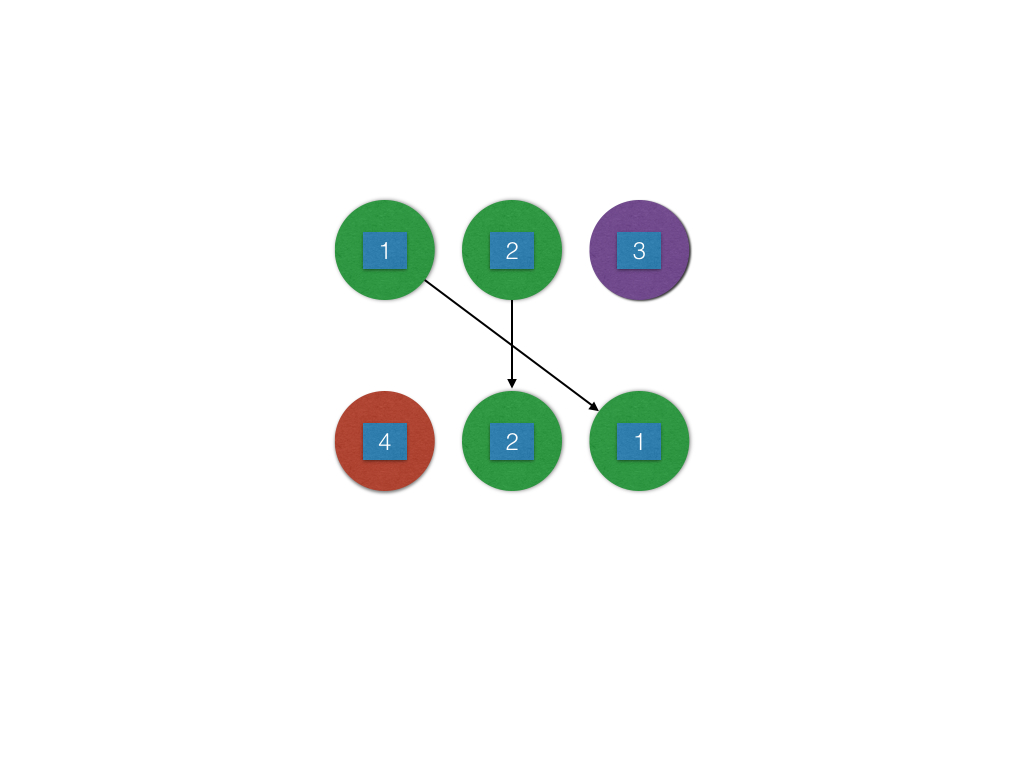
数字我们可以理解为给element的key。正方形代表element。圆形代表了component。当然也是实际上的dom节点的位置。从上到下,我们的4 2 1里 2 ,1可以复用之前的component,让他们通知自己的子节点更新后,再告诉2和1,他们在新的集合里需要移动的位置(在我们这里就是组装差异对象加到队列)。3需要删除,4需要新增。好了,整个的diff就完成了,这个时候当递归完成,我们就需要开始做patch的动作了,把这些差异对象实打实的反映到具体的dom节点上。我们看下_patch的实现:
//用于将childNode插入到指定位置
function insertChildAt(parentNode, childNode, index) {
var beforeChild = parentNode.children().get(index);
beforeChild ? childNode.insertBefore(beforeChild) : childNode.appendTo(parentNode);
}
ReactDOMComponent.prototype._patch = function(updates) {
var update;
var initialChildren = {};
var deleteChildren = [];
for (var i = 0; i < updates.length; i++) {
update = updates[i];
if (update.type === UPATE_TYPES.MOVE_EXISTING || update.type === UPATE_TYPES.REMOVE_NODE) {
var updatedIndex = update.fromIndex;
var updatedChild = $(update.parentNode.children().get(updatedIndex));
var parentID = update.parentID;
//所有需要更新的节点都保存下来,方便后面使用
initialChildren[parentID] = initialChildren[parentID] || [];
//使用parentID作为简易命名空间
initialChildren[parentID][updatedIndex] = updatedChild;
//所有需要修改的节点先删除,对于move的,后面再重新插入到正确的位置即可
deleteChildren.push(updatedChild)
}
}
//删除所有需要先删除的
$.each(deleteChildren, function(index, child) {
$(child).remove();
})
//再遍历一次,这次处理新增的节点,还有修改的节点这里也要重新插入
for (var k = 0; k < updates.length; k++) {
update = updates[k];
switch (update.type) {
case UPATE_TYPES.INSERT_MARKUP:
insertChildAt(update.parentNode, $(update.markup), update.toIndex);
break;
case UPATE_TYPES.MOVE_EXISTING:
insertChildAt(update.parentNode, initialChildren[update.parentID][update.fromIndex], update.toIndex);
break;
case UPATE_TYPES.REMOVE_NODE:
// 什么都不需要做,因为上面已经帮忙删除掉了
break;
}
}
}
_patch主要就是挨个遍历差异队列,遍历两次,第一次删除掉所有需要变动的节点,然后第二次插入新的节点还有修改的节点。这里为什么可以直接挨个的插入呢?原因就是我们在diff阶段添加差异节点到差异队列时,本身就是有序的,也就是说对于新增节点(包括move和insert的)在队列里的顺序就是最终dom的顺序,所以我们才可以挨个的直接根据index去塞入节点。但是其实你会发现这里有个问题,就是所有的节点都会被删除,包括复用以前的component类型为UPATE_TYPES.MOVE_EXISTING的,所以闪烁会很严重。其实我们再看看上面的例子,其实2是不需要记录到差异队列的。这样后面patch也是ok的。想想是为什么呢?我们来改造下代码:
//_diff用来递归找出差别,组装差异对象,添加到更新队列diffQueue。
ReactDOMComponent.prototype._diff = function(diffQueue, nextChildrenElements){
。。。
/**注意新增代码**/
var lastIndex = 0;//代表访问的最后一次的老的集合的位置
var nextIndex = 0;//代表到达的新的节点的index
//通过对比两个集合的差异,组装差异节点添加到队列中
for (name in nextChildren) {
if (!nextChildren.hasOwnProperty(name)) {
continue;
}
var prevChild = prevChildren && prevChildren[name];
var nextChild = nextChildren[name];
//相同的话,说明是使用的同一个component,所以我们需要做移动的操作
if (prevChild === nextChild) {
//添加差异对象,类型:MOVE_EXISTING
。。。。
/**注意新增代码**/
prevChild._mountIndex < lastIndex && diffQueue.push({
parentId:this._rootNodeID,
parentNode:$('[data-reactid='+this._rootNodeID+']'),
type: UPATE_TYPES.REMOVE_NODE,
fromIndex: prevChild._mountIndex,
toIndex:null
})
lastIndex = Math.max(prevChild._mountIndex, lastIndex);
} else {
//如果不相同,说明是新增加的节点,
if (prevChild) {
//但是如果老的还存在,就是element不同,但是component一样。我们需要把它对应的老的element删除。
//添加差异对象,类型:REMOVE_NODE
。。。。。
/**注意新增代码**/
lastIndex = Math.max(prevChild._mountIndex, lastIndex);
}
。。。
}
//更新mount的inddex
nextChild._mountIndex = nextIndex;
nextIndex++;
}
//对于老的节点里有,新的节点里没有的那些,也全都删除掉
。。。
}
如下图,老集合中包含节点:A、B、C、D,更新后的新集合中包含节点:B、A、D、C,此时新老集合进行 diff 差异化对比,发现 B != A,则创建并插入 B 至新集合,删除老集合 A;以此类推,创建并插入 A、D 和 C,删除 B、C 和 D。
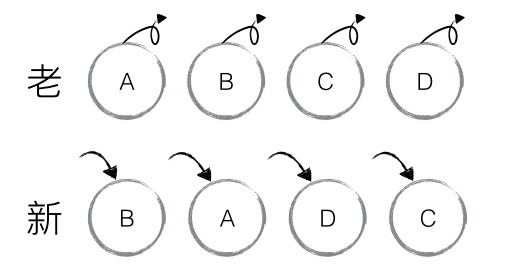
React 发现这类操作繁琐冗余,因为这些都是相同的节点,但由于位置发生变化,导致需要进行繁杂低效的删除、创建操作,其实只要对这些节点进行位置移动即可。针对这一现象,React 提出优化策略:允许开发者对同一层级的同组子节点,添加唯一key进行区分,虽然只是小小的改动,性能上却发生了翻天覆地的变化!新老集合所包含的节点,如下图所示,新老集合进行diff差异化对比,通过key发现新老集合中的节点都是相同的节点,因此无需进行节点删除和创建,只需要将老集合中节点的位置进行移动,更新为新集合中节点的位置,此时 React 给出的 diff 结果为:B、D 不做任何操作,A、C 进行移动操作,即可。
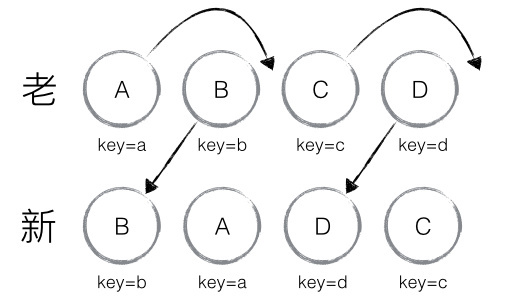
以上图为例,可以更为清晰直观的描述 diff 的差异对比过程:
首先对新集合的节点进行循环遍历,for (name in nextChildren),通过唯一 key 可以判断新老集合中是否存在相同的节点,if (prevChild === nextChild),如果存在相同节点,则进行移动操作,但在移动前需要将当前节点在老集合中的位置与 lastIndex 进行比较,if (child._mountIndex < lastIndex),则进行节点移动操作,否则不执行该操作。这是一种顺序优化手段,lastIndex一直在更新,表示访问过的节点在老集合中最右的位置(即最大的位置),如果新集合中当前访问的节点比 lastIndex 大,说明当前访问节点在老集合中就比上一个节点位置靠后,则该节点不会影响其他节点的位置,因此不用添加到差异队列中,即不执行移动操作,只有当访问的节点比 lastIndex 小时,才需要进行移动操作。
从新集合中取得 B,判断老集合中存在相同节点 B,通过对比节点位置判断是否进行移动操作,B 在老集合中的位置 B._mountIndex = 1,此时 lastIndex = 0,不满足 child._mountIndex < lastIndex 的条件,因此不对 B 进行移动操作;更新 lastIndex = Math.max(prevChild._mountIndex, lastIndex),其中 prevChild._mountIndex 表示 B 在老集合中的位置,则 lastIndex = 1,并将 B 的位置更新为新集合中的位置 prevChild._mountIndex = nextIndex,此时新集合中 B._mountIndex = 0,nextIndex++ 进入下一个节点的判断。
从新集合中取得 A,判断老集合中存在相同节点 A,通过对比节点位置判断是否进行移动操作,A 在老集合中的位置 A._mountIndex = 0,此时 lastIndex = 1,满足 child._mountIndex < lastIndex的条件,因此对 A 进行移动操作enqueueMove(this, child._mountIndex, toIndex),其中 toIndex 其实就是 nextIndex,表示 A 需要移动到的位置;更新 lastIndex = Math.max(prevChild._mountIndex, lastIndex),则 lastIndex = 1,并将 A 的位置更新为新集合中的位置 prevChild._mountIndex = nextIndex,此时新集合中 A._mountIndex = 1,nextIndex++ 进入下一个节点的判断。
从新集合中取得 D,判断老集合中存在相同节点 D,通过对比节点位置判断是否进行移动操作,D 在老集合中的位置 D._mountIndex = 3,此时 lastIndex = 1,不满足 child._mountIndex < lastIndex的条件,因此不对 D 进行移动操作;更新 lastIndex = Math.max(prevChild._mountIndex, lastIndex),则 lastIndex = 3,并将 D 的位置更新为新集合中的位置 prevChild._mountIndex = nextIndex,此时新集合中 D._mountIndex = 2,nextIndex++ 进入下一个节点的判断。
从新集合中取得 C,判断老集合中存在相同节点 C,通过对比节点位置判断是否进行移动操作,C 在老集合中的位置 C._mountIndex = 2,此时 lastIndex = 3,满足 child._mountIndex < lastIndex 的条件,因此对 C 进行移动操作 enqueueMove(this, child._mountIndex, toIndex);更新 lastIndex = Math.max(prevChild._mountIndex, lastIndex),则 lastIndex = 3,并将 C 的位置更新为新集合中的位置 prevChild._mountIndex = nextIndex,此时新集合中 A._mountIndex = 3,nextIndex++ 进入下一个节点的判断,由于 C 已经是最后一个节点,因此 diff 到此完成。
以上主要分析新老集合中存在相同节点但位置不同时,对节点进行位置移动的情况,如果新集合中有新加入的节点且老集合存在需要删除的节点,那么 React diff 又是如何对比运作的呢?
以下图为例:
- 从新集合中取得 B,判断老集合中存在相同节点 B,由于 B 在老集合中的位置 B._mountIndex = 1,此时 lastIndex = 0,因此不对 B 进行移动操作;更新 lastIndex = 1,并将 B 的位置更新为新集合中的位置 B._mountIndex = 0,nextIndex++进入下一个节点的判断。
- 从新集合中取得 E,判断老集合中不存在相同节点 E,则创建新节点 E;更新 lastIndex = 1,并将 E 的位置更新为新集合中的位置,nextIndex++进入下一个节点的判断。
- 从新集合中取得 C,判断老集合中存在相同节点 C,由于 C 在老集合中的位置C._mountIndex = 2,此时 lastIndex = 1,因此对 C 进行移动操作;更新 lastIndex = 2,并将 C 的位置更新为新集合中的位置,nextIndex++ 进入下一个节点的判断。
- 从新集合中取得 A,判断老集合中存在相同节点 A,由于 A 在老集合中的位置A._mountIndex = 0,此时 lastIndex = 2,因此不对 A 进行移动操作;更新 lastIndex = 2,并将 A 的位置更新为新集合中的位置,nextIndex++ 进入下一个节点的判断。
- 当完成新集合中所有节点 diff 时,最后还需要对老集合进行循环遍历,判断是否存在新集合中没有但老集合中仍存在的节点,发现存在这样的节点 D,因此删除节点 D,到此 diff 全部完成。
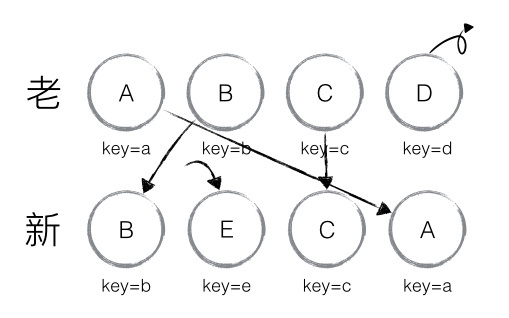
可以看到我们多加了个lastIndex,这个代表最后一次访问的老集合节点的最大的位置。而我们加了个判断,只有_mountIndex小于这个lastIndex的才会需要加入差异队列。有了这个判断上面的例子2就不需要move。而程序也可以好好的运行,实际上大部分都是2这种情况。这是一种顺序优化,lastIndex一直在更新,代表了当前访问的最右的老的集合的元素。我们假设上一个元素是A,添加后更新了lastIndex。如果我们这时候来个新元素B,比lastIndex还大说明当前元素在老的集合里面就比上一个A靠后。所以这个元素就算不加入差异队列,也不会影响到其他人,不会影响到后面的path插入节点。因为我们从patch里面知道,新的集合都是按顺序从头开始插入元素的,只有当新元素比lastIndex小时才需要变更。其实只要仔细推敲下上面那个例子,就可以理解这种优化手段了。这样整个的更新机制就完成了。
我们再来简单回顾下reactjs的差异算法:
首先是所有的component都实现了receiveComponent来负责自己的更新,而浏览器默认元素的更新最为复杂,也就是经常说的 diff algorithm。react有一个全局_shouldUpdateReactComponent用来根据element的key来判断是更新还是重新渲染,这是第一个差异判断。比如自定义元素里,就使用这个判断,通过这种标识判断,会变得特别高效。每个类型的元素都要处理好自己的更新:
- 自定义元素的更新,主要是更新render出的节点,做甩手掌柜交给render出的节点的对应component去管理更新。
- text节点的更新很简单,直接更新文案。
浏览器基本元素的更新,分为两块:
先是更新属性,对比出前后属性的不同,局部更新。并且处理特殊属性,比如事件绑定。
然后是子节点的更新,子节点更新主要是找出差异对象,找差异对象的时候也会使用上面的_shouldUpdateReactComponent来判断,如果是可以直接更新的就会递归调用子节点的更新,这样也会递归查找差异对象,这里还会使用lastIndex这种做一种优化,使一些节点保留位置,之后根据差异对象操作dom元素(位置变动,删除,添加等)。
整个reactjs的差异算法就是这个样子。最核心的两个_shouldUpdateReactComponent以及diff,patch算法。